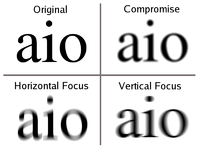
Photo from wikipedia
The incidence of ectasia following refractive surgery is unclear. This review sought to determine the worldwide rates of ectasia after photorefractive keratectomy (PRK), laser-assisted in situ keratomileusis (LASIK), and small… Click to show full abstract
The incidence of ectasia following refractive surgery is unclear. This review sought to determine the worldwide rates of ectasia after photorefractive keratectomy (PRK), laser-assisted in situ keratomileusis (LASIK), and small incision lenticule extraction (SMILE) based on reports in the literature. A systematic review was conducted according to modified Preferred Reporting Items for Systematic Reviews and Meta-Analyses (PRISMA) guidelines. Publications were identified by a search of eight electronic databases for relevant terms between 1984 and 2021. Patient characteristics and preoperative values including manifest refractive spherical refractive equivalent (MRSE), central corneal thickness (CCT), anterior keratometry, postoperative residual stromal bed (RSB), and percent tissue altered (PTA) were summarized. In addition, annual rates of each refractive surgery were determined, and incidence of post-refractive ectasia for each type was calculated using the number of ectatic eyes identified in the literature. In total, 57 eyes (70 eyes including those with preoperative risk factors for ectasia) were identified to have post-PRK ectasia, while 1453 eyes (1681 eyes including risk factors) had post-LASIK ectasia, and 11 eyes (19 eyes including risk factors) had post-SMILE ectasia. Cases of refractive surgery performed annually were estimated as 283,920 for PRK, 1,608,880 for LASIK, and 96,750 for SMILE. Reported post-refractive ectasia in eyes without preoperative identifiable risk factors occurred with the following incidences: 20 per 100,000 eyes in PRK, 90 per 100,000 eyes in LASIK, and 11 per 100,000 eyes in SMILE. The rate of ectasia in LASIK was found to be 4.5 times higher than that of PRK. Post-refractive ectasia occurs at lower rates in eyes undergoing PRK than LASIK. Although SMILE appears to have the lowest rate of ectasia, the number of cases already reported since its recent approval suggests that post-SMILE ectasia may become a concern. Considering that keratoconus is a spectrum of disease, pre-existing keratoconus may play a larger role in postoperative ectasia than previously accounted for in the literature.
Journal Title: Ophthalmology and Therapy
Year Published: 2021
Link to full text (if available)
Share on Social Media: Sign Up to like & get
recommendations!